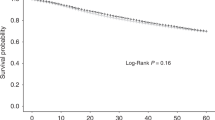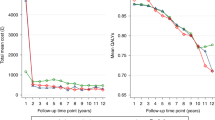Abstract
The aim of this study was to determine the treatment patterns and resource utilization of various prostate cancer treatments, and quantify the economic and clinical impact of each. In a retrospective analysis of medical and pharmacy claims between 2000 and 2005, using the PharMetrics database, male patients aged ≥40 years with prostate cancer diagnosis were identified. The costs of medical and prostate cancer-related expenditures for the treatment options were determined for three periods: from diagnosis to first treatment, during and after treatment. A total of 9035 patients were included. The mean age of patients diagnosed with prostate cancer was 61.4 years. Patients aged 50–59 years represented the highest proportion at 51%. The majority received some form of treatment. Watchful waiting (WW) was the primary means of management for 30%. The average 2-year cost for WW was $24 809 and for active treatment was $59 286. Surgery was the most common treatment among younger men. Non-cancer-related costs were similar among those receiving treatment or WW, but prostate cancer costs were over five times greater in the treated patients. With or without treatment, prostate cancer is a significant clinical and economic burden to society. New strategies for treatment or cancer prevention could play a role in reducing this burden.
This is a preview of subscription content, access via your institution
Access options
Subscribe to this journal
Receive 4 print issues and online access
$259.00 per year
only $64.75 per issue
Buy this article
- Purchase on Springer Link
- Instant access to full article PDF
Prices may be subject to local taxes which are calculated during checkout






Similar content being viewed by others
References
American Cancer Society. Cancer Facts & Figures 2007. American Cancer Society: Atlanta, 2007.
American Cancer Society (ACS). Cancer Facts & Figures: 2008. Available at http://www.cancer.org/downloads/STT/2008CAFFfinalsecured.pdf; accessed March 2008.
National Cancer Institute (NCI). Cancer Trends Progress Report—2007 Update. Available at http://progressreport.cancer.gov; accessed March 2008.
Chodak G . Prostate cancer: epidemiology, screening, and biomarkers. Rev Urol 2006; 8: S3–S8.
Johansson JE, Holmber L, Johansson S, Bergström R, Adami HO . Fifteen-year survival in prostate cancer: a prospective, population-based study in Sweden. JAMA 1997; 277: 467–471.
Chang S, Long SR, Kutikova L, Bowman L, Finley D, Crown WH et al. Estimating the cost of cancer: results on the basis of claims data analyses for cancer patients diagnosed with seven types of cancer during 1999 to 2000. J Clin Oncol 2004; 22: 3524–3530.
Penson DF, Moul JW, Evans CP, Doyle JJ, Gandhi S, Lamerato L . The economic burden of metastatic and prostate specific antigen progression in patients with prostate cancer: findings from a retrospective analysis of health plan data. J Urol 2004; 171: 2250–2254.
International Classification of Diseases. Ninth Revision, Clinical Modification (ICD-9-CM). Centers for Disease Control and Prevention: Hyattsville, MD, 1979.
Mag Mutual. Physician's Fee and Coding Guide 2008. MAG Mutual Healthcare Solutions, Inc: Atlanta, GA, USA
Yan Y, Carvalhal GF, Catalona WJ, Young JD . Primary treatment choices for men with clinically localized prostate carcinoma detected by screening. Cancer 1999; 88: 1122–1130.
Bill-Axelson A, Holmberg L, Ruutu M, Häggman M, Andersson SO, Bratell S et al. Radical prostatectomy versus watchful waiting in early prostate cancer. N Engl J Med 2005; 352: 1977–1984.
National Comprehensive Cancer Network and American Cancer Society, Prostate Cancer. Treatment Guidelines for Patients, Version VI, October 2007.
Anastasiadis AG, Salomon L, Katz R, Hoznek A, Chopin D, Abbou CC . Radical retropubic versus laparoscopic prostatectomy: a prospective comparison of functional outcome. Urology 2003; 62: 292–297.
Cohn JH, El-Galley R . Radical prostatectomy in a community practice. J Urol 2002; 167: 224–228.
Cooperberg MR, Moul JW, Carroll PR . The changing face of prostate cancer. J Clin Oncol 2005; 23: 8146–8151; review.
Albertsen PC, Hanley JA, Fine J . 20-Year outcomes following conservative management of clinically localized prostate cancer. JAMA 2005; 293: 2095–2101.
Wallace, M . Uncertainty and quality of life of older men who undergo watchful waiting for prostate cancer. Oncol Nurs Forum 2003; 30: 3003–3309.
Bailey DE, Wallace M . Critical review: is watchful waiting a viable management option for older men with prostate cancer? Am J Men's Health 2007; 1: 18–28.
Lippman SM, Klein EA, Goodman PJ, Lucia MS, Thompson IM, Ford LG et al. Effect of selenium and vitamin E on risk of prostate cancer and other cancers: the Selenium and Vitamin E Cancer Prevention Trial (SELECT). JAMA 2009; 301: 39–51.
Musquera M, Fleshner NE, Finelli A, Zlotta AR . The REDUCE trial: chemoprevention in prostate cancer using a dual 5alpha-reductase inhibitor, dutasteride. Expert Rev Anticancer Ther 2008; 8: 1073–1079.
Andriole GL . Headline results of the REDUCE trial: the effect of dutasteride on prostate cancer risk reduction. Presented at: American Urological Association 2009 Annual Meeting; April 25–30, 2009; Chicago, IL. http://webcasts.prous.com/AUA2009/html/1-en/template.aspx?section=20&idl=7632&eid=212; accessed July 24, 2009.
Brown ML, Riley GF, Schussler N, Etzioni R . Estimating health care costs related to cancer treatment from SEER-Medicare data. Med Care 2002; 40 (Suppl 8): IV104–117.
Thompson IM, Goodman PJ, Tangen CM, Lucia MS, Miller GJ, Ford LG et al. The influence of finasteride on the development of prostate cancer. N Engl J Med 2003; 349: 215–224.
Thorpe JF, Jain S, Marczylo TH, Gescher AJ, Steward WP, Mellon JK . A review of phase III clinical trials of prostate cancer chemoprevention. Ann R Coll Surg Engl 2007; 89: 207–211.
Acknowledgements
Funding for the research described in this paper, as well as for preparation of the paper, was provided by GlaxoSmithKline to Xcenda, LLC.
Author information
Authors and Affiliations
Corresponding author
Ethics declarations
Competing interests
Drs Eaddy and Kruep are employed at Xcenda. Dr Crawford received an honorarium from Xcenda for his professional services relevant to this study and the paper. Dr Black is employed at GlaxoSmithKline.
Rights and permissions
About this article
Cite this article
Crawford, E., Black, L., Eaddy, M. et al. A retrospective analysis illustrating the substantial clinical and economic burden of prostate cancer. Prostate Cancer Prostatic Dis 13, 162–167 (2010). https://doi.org/10.1038/pcan.2009.63
Received:
Revised:
Accepted:
Published:
Issue Date:
DOI: https://doi.org/10.1038/pcan.2009.63
Keywords
This article is cited by
-
Herb-target virtual screening and network pharmacology for prediction of molecular mechanism of Danggui Beimu Kushen Wan for prostate cancer
Scientific Reports (2021)
-
Midterm oncological outcome and clinicopathological characteristics of anterior prostate cancers treated by endoscopic extraperitoneal radical prostatectomy
World Journal of Urology (2014)
-
Comparing Hospital-Based Resource Utilization and Costs for Prostate Cancer Patients With and Without Bone Metastases
Applied Health Economics and Health Policy (2014)
-
Statin use and risk of prostate cancer and high-grade prostate cancer: results from the REDUCE study
Prostate Cancer and Prostatic Diseases (2013)
-
HIFU is effective, but associated morbidity still remains unclear
Nature Reviews Urology (2010)



